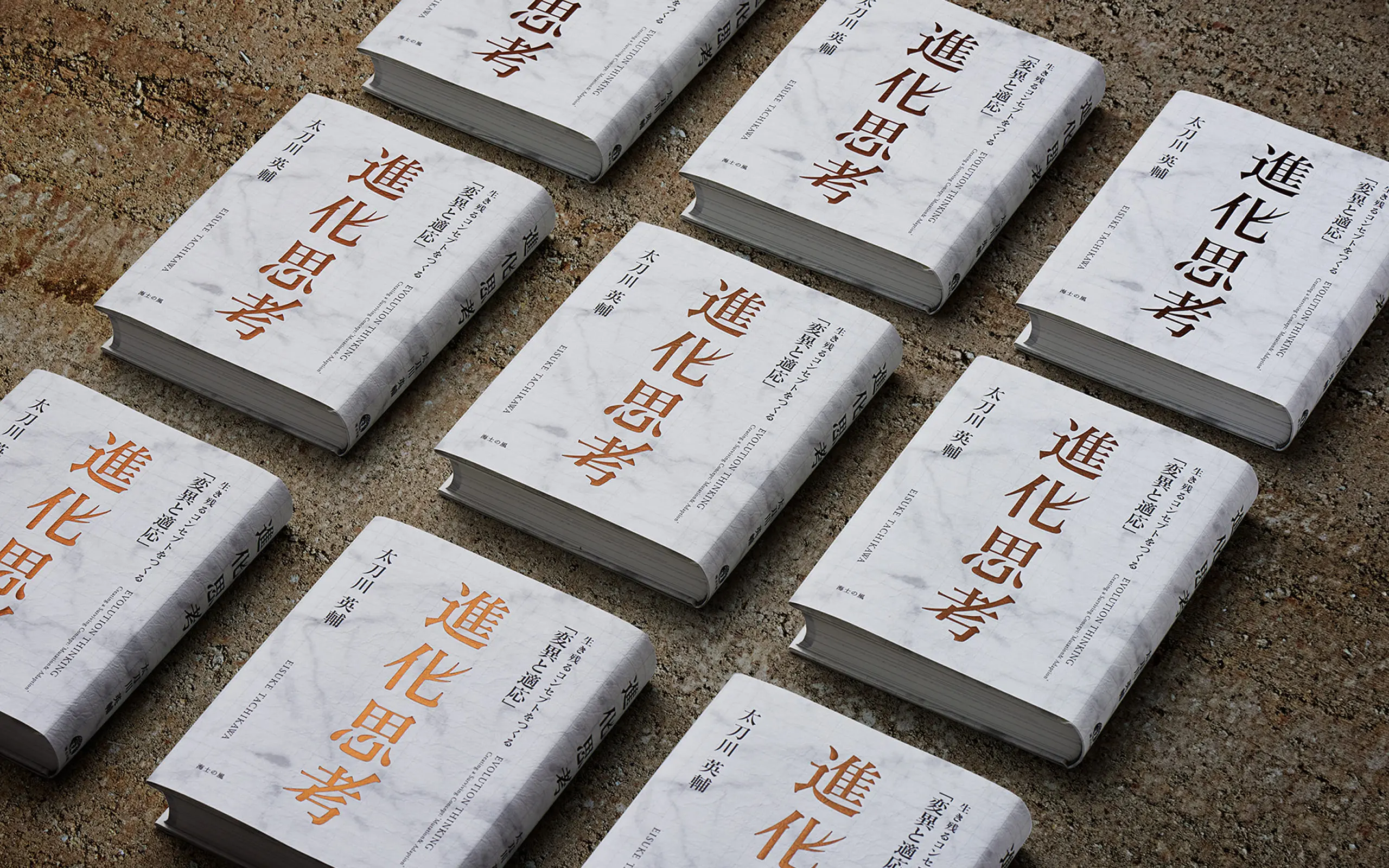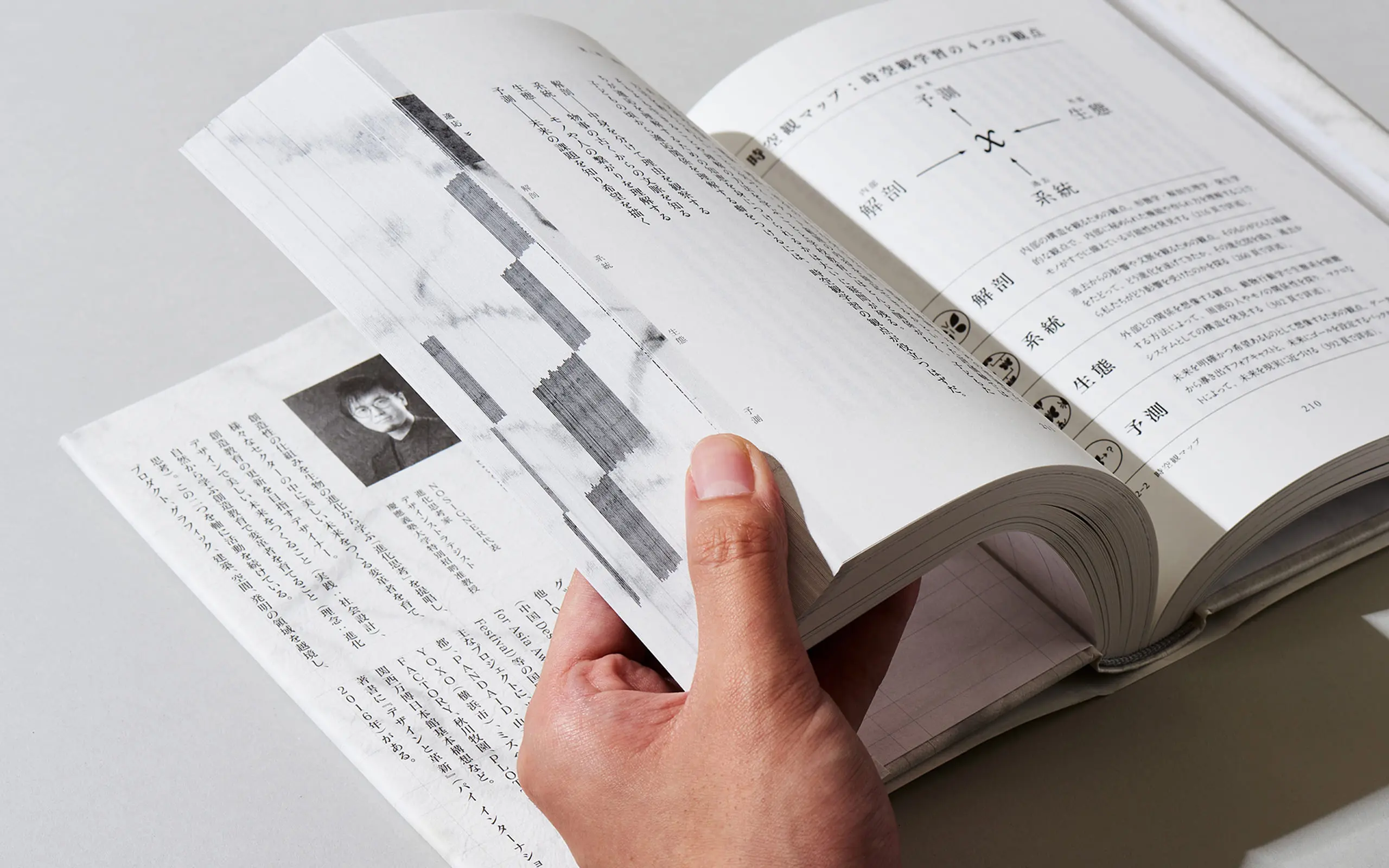
PROJECT
進化思考
生物進化に学ぶ創造的思考法。70超の企業や大学に導入され、山本七平賞を受賞。中韓尼など多言語に翻訳され、世界に広がる。

WHY
「創造性」とは才能ある
人だけのものなのか。
私たち人類はあらゆる欲求を叶えるために、「創造性」によってさまざまな道具を生み出し、社会を発展させてきました。それほど重要な力であるにもかかわらず、これまで「創造性」は先天的な能力として語られることが多く、天賦の才がなければ優れた創造性は発揮できないと考えられがちでした。果たして、創造性とは学習できないものなのでしょうか。
レイモンドキャッテル「結晶性知能と流動性知能のグラフ」

2030アジェンダ169のSDGsターゲットの達成状況 (2015年時点)

自分のことを「創造的」だと思う日本生徒の割合

美術の授業で絵が下手だった、などの簡単なつまづきで自らの創造性を諦めてしまう人たちが後を絶ちません。その残念な結果として、日本では自分自身を「クリエイティブ」だと感じる学生は8%しかいない、という調査結果もあります。
しかし、創造性について本当に私たちは深く理解しているのでしょうか。そう考えると創造性という現象の構造や訓練方法について、私たちはほとんど知らないことに気づきます。創造性の構造を把握できれば、私たちはこれを後天的に学ぶことができるかもしれません。
近年の学校教育では、「アクティブラーニング」や「探求学習」など、学習者の能動性を尊重し、教科の枠にとらわれない創造性や探究心を育む教育に目が向けられるようになりました。また、ビジネスの現場においても、創造的な発想を促す思考法が注目を集めるようになっています。
創造的なプロジェクトを生み出せる人を増やすことは、持続可能な社会の構築や様々な社会課題の根本的な解決にもつながるはずです。そのためにも、創造性そのものを理解し、体系的に学ぶことができる理論や教育の確立が求められています。


HOW
生物の進化から、
創造性教育を体系化する。

人間の創造性は、自然界にとって超常的と言えるほど特殊な現象に思えます。38億年の生命の歴史の中に刻まれる数千万種の生物の中で、これほど創造性を発揮した生物を他に見つけることはできません。しかし、私たち人間も自然の一部であるという観点に立つと、人間が発揮する創造性も自然現象のひとつであるはずです。
一方で私たちは、自然物の造形に対して人間以上の創造性を感じることがあります。それはなぜなのでしょうか。
こうした観点から、人間の創造性は生物の進化に近い現象なのではないかと考えたNOSIGNER代表の太刀川英輔は、進化という現象から創造性を構造化する探求を続けてきました。そして、生物の進化の構造をデザインやイノベーションに応用するための創造的思考法「進化思考」を体系化するに至りました。
生物は、偶然によって起こる「変異」と環境などの条件による必然的な「選択」の2つのプロセスを、遺伝によって何世代も繰り返して進化します。
もし私たちの創造性がこれと同じ構造を持っているとすれば、社会の変革を実現してきた人類の発明やイノベーションの多くも、偶然と必然の思考の往復から生み出されていると考えられるはずです。偶然にも必然にも意志はなく、単純に往復すれば適応に近づいていくのです。
創造性は作り手の意思によらず自律的に起こる現象である。そうした考えのもと、常識にとらわれずにクレイジーな偶然を生み出す「変異的思考」と、状況から必然的な適応の方向を観察する「選択的思考」を何世代も往復するプロセスとして創造性を捉えるのが進化思考です。



かねてからデザインと言語の関係について研究してきた太刀川は、人間の創造性の源泉を「言語」だと考えてきました。そして生物の進化の鍵をにぎるのは、言語によく似た「DNA」の変異です。
DNAのコピーエラーと、言語の言い間違いや聞き間違いはよく似ています。この前提によって、進化と創造では類似した変異のパターンが発生する、というのが太刀川の仮説です。
実際に生物の進化と共通するパターンがさまざまな発明や文化の中にも見られます。進化思考では、この類似するパターンを創造のプロセスに応用し、アイデアを生み出すためのエラーの「型」を9つに分類しています。
「変量」「消失」「融合」「逆転」「分離」「交換」「擬態」「移動」「増殖」という9つの変異のパターンをツールボックスのように活用していくことで偶然のエラーを大量発生させ、多くのアイデアを短時間で効率的に生み出す。これが変異的思考です。
それでは、どうすればこれらのエラーの中から良いアイデアを選べるのでしょうか。自然界において、生物の環境への適応は観察できる現象です。長い歴史の中で自然科学者たちが培ってきた自然観察のアプローチに学べば、適応的な発想を選択できるかもしれません。
太刀川は様々な自然科学の観察手法を考察する中で、観察には「時間」と「空間」にまたがる4つの観点しかなく、それぞれが生物学的な観察の体系として確立されてきたことに気づきます。そして、内部の構成要素を把握する「解剖」、外部の環境を理解する「生態」、過去にさかのぼって進化の系譜を読み解く「系統」、FORECAST型、BACKCAST型の2つのアプローチから未来を考察する「予測」という4つの「適応」の手法を体系化し「時空観学習」と名付けました。時間と空間にまたがる4つの観点から状況を分析することで、社会の必然的な選択圧を理解し、これらに対応し得る強度のあるアイデアを選択できるようになります。

「進化思考」は、これらの「変異」と「選択」の思考を駆使し、2種類の思考を往復しながら、永い時間を生き残る創造的なコンセプトをつくり出すための思考法です。
(書籍『進化思考』の第一版では偶然の変異と自然選択で近づく適応を指して「変異と適応」の往復と表現していましたが、改訂版以降は学術的な正確性を高めるために「変異と選択」の往復という表現に改めています)


2021年4月には日本の辺境にある人口約2,000人の離島、島根県海士町に初めて設立された出版社「海士の風」による1冊目の本として、進化思考の書籍が発売されました。辺境からの出版にも関わらず、この本はAmazonのビジネス・経済書ランキングで1位のベストセラーを獲得。発売1週間で3刷3万部を記録し、その後も爆発的に広がりを見せています。
さらにこの書籍は、日本国内で数多くの賞を獲得することになります。顕著なものとして、日本を代表する人文科学分野の書籍に数年に一度与えられる名誉ある学術賞「山本七平賞」を受賞しました。選考委員は解剖学者の養老孟司氏、進化生物学者の長谷川眞理子氏という二人の生物学者、社会科学の分野で活躍する経済学者の伊藤元重氏、政治学者の中西輝政氏、法学者の八木秀次氏が務め、まさに文理を超えた学術的な評価をいただくことができました。
私たちはこの進化思考を通して、辺境からでも世界は変わりうることを証明するとともに、全く新しい創造性教育を世界に発信していきたいと考えています。
CLIENT VOICE
進化にはさまざまな法則が認められている。著者はそれらを参考にして、いわゆるイノベーションの参考資料にしようとする。
各論については、本書を読んでいただくしかないが、進化における諸法則を応用して考えるという着想の新しさは、たんなるノウハウ本の域をはるかに超えている。
各項目に関して述べられる事例も生き生きとしていて、読み物としても面白い。この点は、著者が絶えず思考を止めないことを示している。地球上での三十五億年の生物進化の解答が現在のわれわれであって、その過程がわれわれを創りあげてきた。それならその過程を左右した法則が、今後の過程の進行の参考にならないはずがない。
著者の方法は基本的にはアナロジーであり、動物行動学者のコンラート・ローレンツはノーベル賞受賞講演のなかで、自分の方法はアナロジーだけだ、と述べた。いわゆる「独創性」を重視する学問研究の世界では、これをいう人は少ない。しかしイノベーションのように「独創性」が重視される局面では、アナロジーのもつ意味は重要で、本作品はその意味で貴重であり、山本七平賞に値するものといえよう。
有限会社 養老研究所 /
東京大学 名誉教授
養老孟司

進化思考のブックデザインは、著者である太刀川自身によるものです。
時代を超えて愛され続ける本のあり方を考え、悠久の時の中で積み重ねられていく地層にインスパイアされ、岩のような風合いや質感を持つ本をデザインすることにしました。ここには、チャールズ・ダーウィンの進化論に影響を与えたと言われるジェームズ・ハットンの地質学研究へのオマージュが込められています。
カバーには、鉱物のようなテクスチャを持つエンボスパターンの紙「岩はだ」を採用し、そこに大理石のパターンを印刷しました。同様のパターンを小口にも展開することで、500ページを超える同書に重厚でソリッドな岩のような佇まいを持たせています。また、装飾を極力排したミニマルなデザインで全体のトーンを統一することで、トレンドに左右されないタイムレスな魅力を表現しました。

本書のタイトルロゴは、「進化思考」の変異のパターン「増殖」「擬態」「反転」「変量」にもとづいて、「進」「化」「思」「考」の4つの漢字を変化させたものです。また、カバーを取り外すと現れる表紙では、同じ4つの漢字を用いて、適応における「解剖」「系統」「生態」「予測」の4つの時空観学習の考え方をヴィジュアライズしています。
ロゴの印刷においては、正面から見ると黒に見え、角度を変えると茶色に輝く村田金箔の「コーヒーブラウン」を箔押しすることで、大理石の中に鈍く輝く宝石が埋まっているようなイメージを演出しました。

本文の組版では、著者がブックデザイナーを兼ねるメリットを活かし、図版に合わせて文字を回り込ませる組版を実践するなど、テキストとヴィジュアルが一体となった読書体験を提供することを心がけました。大理石のパターンを用いたインデックスで検索性を高め、再読を促す仕掛けを施しています。


企業や大学での創造性ワークショップから始まった本であることを活かし、創造的な発想を促す50のワークを収録。ただ読むだけでなく創造的な発想の実践に挑戦できる教科書にもなっています。500ページを超える大著でありながら、読みやすさと使いやすさを兼ね備えた本書は、「創造性」と「生物進化」の百科事典として、何度も読み返すことができる一冊となっています。




WILL
創造性教育を
アップデートし持続不可能な
世界を超える。
進化思考は、パナソニックや富士通、積水ハウス、慶應義塾大学などの日本の大企業や教育機関で取り入れられるようになり、世界最強のイノベーションの手法という評価を専門家の皆様からいただいています。さらに同志社大学において国語の入試問題に選ばれるなど、大きな広がりを見せています。そして、この創造的思考を実践し、持続可能性のための新たなプロジェクトなど社会に変革を生み出す人たちが数多く現れ始めています。
また日本屈指のAIの専門家が進化思考のメカニズムを取り入れた人工知能の開発に乗り出し、国内最大規模の生息環境展示を行う動物園で進化思考を用いたワークショップが行われるなど、進化思考は徐々にその輪を広げています。
しかしながら、真に創造的な教育を自然の摂理に学ぶプロジェクトは、まだ始まったばかりです。
私たち人類は、テクノロジーの恩恵を受けながら現在も成長を続けていますが、その代償として地質や気候は大幅に変動し、生態系の崩壊が進んでいます。人類の活動が地球に重大な影響を与える「人新世」に突入したと言われています。不可逆的かつ急激な環境変化の危険性がある限界点「惑星の限界=プラネタリーバウンダリー」をすでに超え、文明はあと数十年しかもたないとも言われる中、私たちに残された時間的猶予はありません。


人類は、自らの創造性を近視眼的に発揮することによって文明崩壊の危機を招いてしまいましたが、私たちが地球上で生き残っていくために用いることができる唯一の武器もまた私たちの創造性にほかならないはずです。いまこそ私たちは創造性の本質を深く理解し、さまざまな課題の解決のために最大限活用することで、持続可能な共生社会を実現することが求められています。
19世紀に活躍した幼児教育の祖、フリードリヒ・フレーベルは、自然科学に着想を得た創造的な教育思想によって後のバウハウスなどに多大な影響を与え、創造性教育の基盤をつくりました。私たちが目指しているのは、バウハウス以降100年来変わることができなかった創造性教育を進化させることです。
私たちはそれぞれの人がそれぞれの場所で創造性を最大限に発揮し、人類の大きな宿題であるさまざまな社会課題がクリエイティブに解決される状況を生み出すために、進化思考によって時代の創造性教育をアップデートしたいと考えています。



予約販売開始まもなくAmazonビジネス・経済書ランキングで1位となり、瞬く間に発売前重版が決定した『進化思考』。誰しもの中に眠る創造性を呼び起こす新しい思考法とは。
Book information 書籍情報 /
Book Name 書籍名:Evolutional Creativity 進化思考―生き残るコンセプトをつくる「変異と適応」
Publisher 出版社:Amanokaze 海士の風
Price 値段:¥3,300 (Tax Included 税込)
Publisher Date 発売日:2021/4/21
関連ウェブサイド /

INFORMATION
- What
- Evolutional Creativity
- When
- 2016-
- Where
- Japan
- Scope
- Branding / Branding Strategy / Logo / Edition / Business card / Motion logo / Promotional items / Infographics / Photograph / Book cover and inner page design / Exhibition / Poster / Concept Development
- Award
- The 30th Shichihei Yamamoto Prize
- SDGs
CREDIT
- Inventor
- Eisuke Tachikawa
- Thanks
Amanokaze (kazetotuchito Inc. ),Eiji Press Inc. , NOSIGNER staffs,Ginza Graphic Gallery , Yuichi Hisatsugu, Kunihiko Sato











